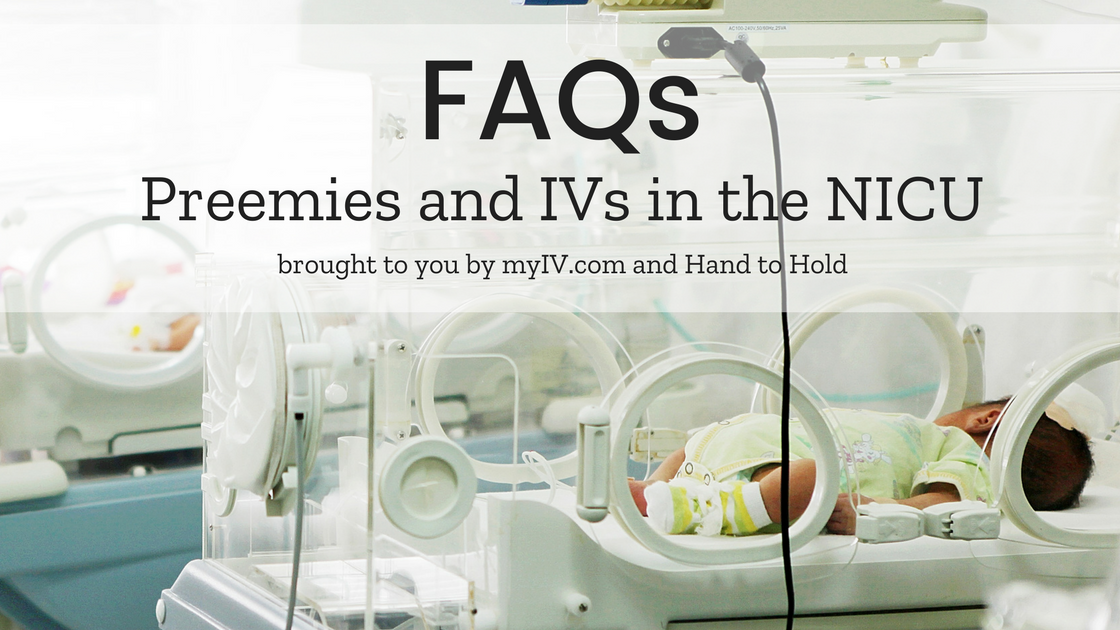
When your baby is admitted to the neonatal intensive care unit (NICU), a dedicated medical team quickly begins a number of procedures to ensure your baby is receiving the care they need. One of the procedures your preemie is likely to experience is IV therapy for fluids and nutrition. We’ve partnered with ivWatch and myIV.com to answer some frequently asked questions about preemies and IVs.
How does IV therapy work?
Intravenous (IV) therapy is the delivery of fluids, blood, or medication directly into a patient’s system through the veins. The main advantage of IV treatments is the ability to quickly introduce these fluids into the body. Preemies may receive IV therapy to administer essential fluids and electrolytes, blood transfusions, or medications.
Where will my child’s IV be placed?
A preemie’s veins are much smaller and more fragile than an adult’s. There are different options for IV placement depending on where the medical staff can locate the best vein for the prescribed therapy.
Common IV placements are in the hand, arm or foot, but a vein in your child’s scalp may also be used. Veins in the head are often large and more visible, making IV placement easier. While it may look strange , know that your baby is receiving the vital nutrition or medication he or she needs.
What is my child receiving through their IV?
Four out of five U.S. hospital patients receive an IV, making it one of the most common procedures. The medication or fluids a baby receives through their IV depends on their condition(s).
IV therapy can be effective for a number of conditions for premature babies including:
- Dehydration
- Inability to feed on their own
- Blood transfusions
- Antibiotics and other medications
It is important to be your baby’s IV advocate, so you should always speak with your medical team and ask what medications or fluids your baby is being given.
Is it safe?
Eighty percent (80%) of admitted U.S. hospital patients receive an IV, yet the current failure rate is fifty percent (50%).
Although it is considered a routine procedure, like any medical procedure, there are risks involved. Talk to your baby’s medical team to make sure they are being monitored for possible complications like infiltration, phlebitis and infection.
Due to their inability to communicate pain, preemies are at a higher risk for infiltration, which occurs when the fluid leaks out of the vein and into the surrounding tissue. Routine hourly checks of the IV site are recommended.
Are there any complications I should look out for?
There should not be any discomfort with the IV. Redness, bruising, itching and inflammation could be signs of a more serious complication.
Complications: infiltrations, phlebitis (inflammation of the vein) and infection. Symptoms to look out for include inflammation (swelling), blistering, or pain near or around the IV placement site.
Typically, pain is felt when the IV is flushed, so for infants or those who can’t talk, look for crying or wincing when flushing the IV.
What if I think something is wrong with my child’s IV?
If you notice your baby developing symptoms such as swelling, tightness and/or redness around the IV site, alert your medical team right away, as these can be signs of complications.
One way to check your child’s IV is using Touch, Look, Compare (T-L-C).
- Touch – Around the IV site should feel soft, warm, dry and pain-free.
- Look – The IV should look dry, uncovered, and have no redness.
- Compare – If your child’s IV is in their right foot, compare it to their left foot. It should be the same size as the other side with no swelling or color changes.
Are there different types of IVs?
There are several different types of IVs, and the type of device placed is based on the medical team’s assessment, the type of medication needed and the anticipated length of time the IV is required.
Peripheral IVs (Peripheral Venous Catheters) are a very common type of IV, but typically don’t remain in for more than 4 days. In the NICU, peripheral IVs are used for certain conditions when medications are needed and must be given through the veins.
Peripherally Inserted Central Catheters (PICC lines) are more invasive, leading directly into the heart and can be left in for several weeks/months.
Midline Catheters are a less invasive method than the Central Line for delivering fluids, medications or drawing blood samples. They can be left in the patient for more than five days but less than a month.
I still have more IV questions. Where can I learn more information?
For answers to your IV questions, myIV.com is the resource to empower and inform patients and caregivers on IVs and IV therapy.
